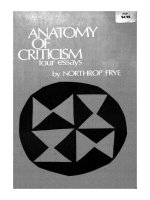OB lecture 11 individual behavior ability anatomy of strengths
Bạn đang xem bản rút gọn của tài liệu. Xem và tải ngay bản đầy đủ của tài liệu tại đây (286.17 KB, 46 trang )
Lecture 11
Individual Behavior at Work
Ability and Personality
Assignment 1
Please submit partial work:
1.0 Introduction
2.0 Organizational Structure
Next Thursday
I will send you a suggested format
Individual Behavior at Work
=> Performance at work
MARS Model of Individual Behavior at
Work and Results
Value
Motivation
Situation
Factors
Personality
Ability
Perception
Emotion
Attitudes
Behavior
and Results
Role
Perception
Stress
J.P Champbell and R.D. Pritchchard
Motivation Theory in Industrial and Organizational Psychology
Handbook of Industrial and Organizational Psychology
Motivation
Forces within a person that affect his or her direction,
intensity, and persistent of voluntary behavior
Ability
Thins that a person can do, or is good at ‘strengths’.
Role Perception
The extend a person understand what he or she should do.
Situation Factors
External events or situation support or interferes with task
goal
Tex t book Page 115 - 136
Value
Personality
P.116
Perception
P.122
Emotion
Attitudes
P. 125
Stress
P.130
Motivation
P.125
(Attitude)
Ability
P.127
Role
Perception
P.122
Situation
Factors
Behavior
and Results
Assignment Writing
1. Best if you can interview or person, and
analyze his/her behavior using the
model
or Analyze your own performance at
school this or previous, or work
experience
2.
Or case study
In the following Headings
Motivation
Ability
Personality
Role Perception
Situation Factors
Emotion
Stress
Week 4
1. Ability
2. Personality
A Person’s Ability or
Strengths Consists of - Acquired
An
Anatomy
Knowled
ge
Talent
Ability
Innate
Skills
Innate and Acquired
Innate – Born with it
Talent
Acquired Later
Knowledge
Factual or experiential learning
Skills
Steps of doing some things
Innate and Acquired
We believe that we can train the technical
Skills – that is the easy part. What we can
nottrain is the service orientation. We just
can’t put people in the training program
and say that they are going to come out
smiling if that is not inherent in them
Carolyn Clark
Senior Vice President of Human Resources
Fairmont
Hotel
Talent
Talent is innate, like a person is borne
tall or short
“Synoptic Connection”
Synapse, cells (nerons), networks
100 billion cells
John Bruer’s – The Myth of The First
Three Years
3 years old – forming of network
15 years – erasing of network
Piaget
Knowledge
Factual
Knowledge
Diploma in
management
Knowledge
Experience,
Experiential
Knowledge
Experience in
managing
Kolb’s Learning Cycle
Try
Practice
experiential
Review
Theory
Factual
Skills
Example
Use of Power Point, Excel
Your Talents
Talent is any recurring pattern of
thoughts,
feeling, or behavior that can be
productively
applied.
Indications of Talent
1. Liking, enjoyment
2. Yearning
3. Rapid learning
4. Instantaneous response
It is important to discover one’s strength
at
school or at work.
Indication of a Talent
Liking, enjoyment
Indication of a Talent
Yearning ‘desire’
Indication of a Talent
Rapid Learning
Indication of a Talent
Instantaneous response
‘unprepared response’
How Do You Know Your Strengths ?
Journaling









